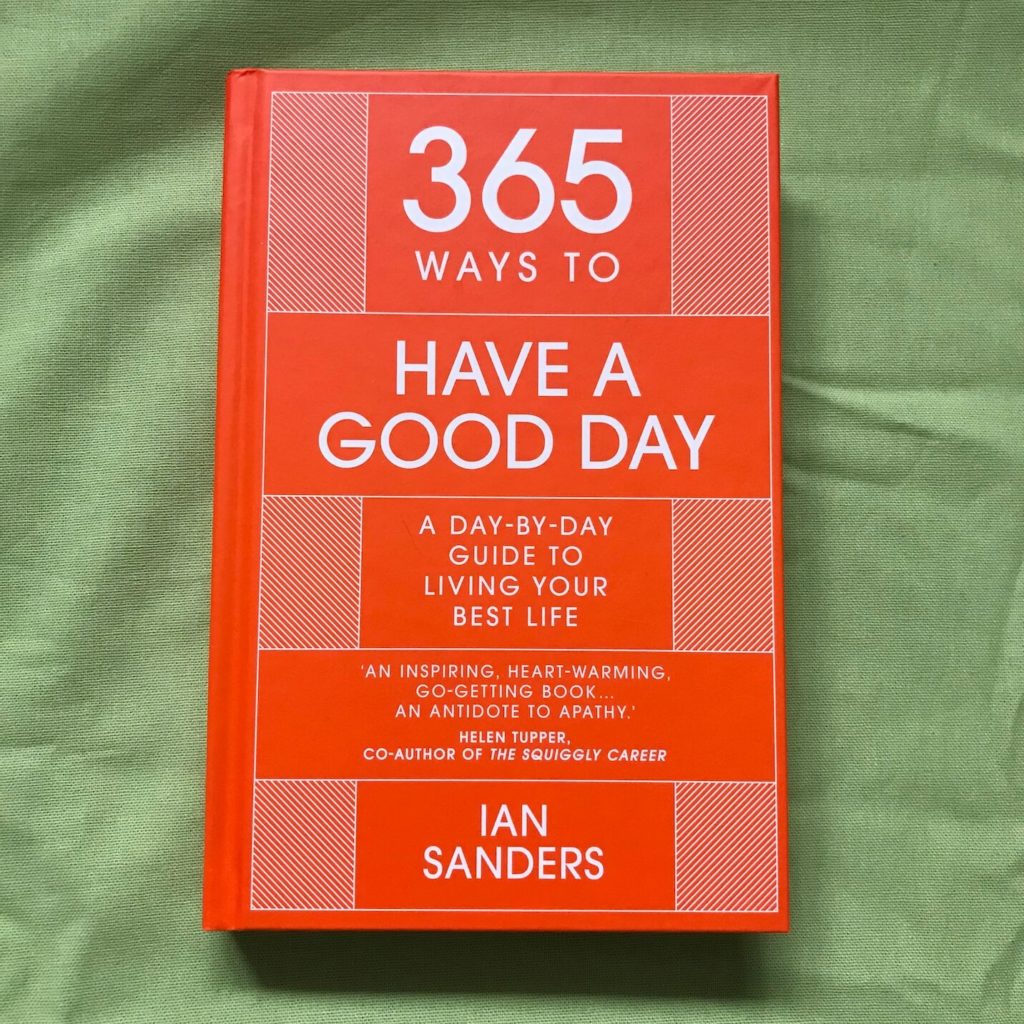

365 ways to have a good day sounds like a book we would all love to live by. When was the last time you had 365 days of ‘good days?’, most likely you haven’t… none of us have. As a guide including stories to inspire, prompts to trigger ideas and tips to test, this book is written with the aim of helping you become more productive, creative, fulfilled and happier. Sadly the book is not a designated map to guarantee 365 days of good days… if only! But it is a book full of inspiration and thought provoking points that make you reflect on your life, your purpose and your wants.
Broken into 13 chapters, 365 ways to have a good day covers habits and hacks to progress through, accumulating in the point “stick to who you are” which sums it all up. While there’s a vast array of tips, tricks and life wisdom to be taken from this book, if there’s one thing to come away with it’s the concept of being true to yourself and following the path that feels the most ‘you’. Ian Sanders shares the line
“I believe so many of us would be happier – and more successful too – if only we could be better at being ourselves.”
which not only sums up the point, the chapter and the book, but also sums up true happiness.
While we could leave you with that one, favourite, point of the book and know that alone sums up the importance and weight of this book, we’re celebrating world book day! So instead we’ve picked out 13 of our favourite points in 365 ways to have a good day, one for every chapter:
1. Track your Good Times
This was a hard one to pick a favourite as there are so many amazing sections in this first chapter, from knowing yourself, accepting the unfinished and appreciating downtime but at the core there is one that seems to be the foundation for them all. Ian Sanders refers to tracking his Good Times as his best metric for success, and it makes sense. Recording your good days over a period of time will help you find the patterns, see the happiness and better understand yourself in the process.
2. Unplan your life
Chapter 2 is no less packed full of tips, getting more detailed and into the nitty gritty of finding happiness each day. The one that stood out though, is not a tip that will help add some happiness into the day today, but one that opens freedom and takes away the stress. “No one knows what’s round the corner, so why try to guess the future? . . . It means I can stay closer to who I am and the work I want to do, that’s my compass”
3. Get some plasters
Now the title of this point alone does not give one of those “ah-ha” moments where things click and feel aligned, yet as we keep reading it becomes clear that this is one of those sections that makes fundamental realisation happen, we just don’t know it from the title. It starts explaining that having more good days is not about ignoring the hard parts in life and goes on to explain “It’s about taking positive action to notice, celebrate and amplify the good bits.”
4. Don’t defer your happiness
If there ever was a life lesson to take on board, this is it. As explained in the book, the old school career model saw us working for four decades before retiring, with all our grand plans deferred until retirement when we’d take that big trip we’d always wanted. Now, with the traditional concept of retirement gone, we’re working harder and for longer so as Ian Sanders says “Let’s embrace that spirit of living in the now, and not putting off your hopes and dreams until later.”.
5. Head towards what magnetizes you
It sounds so simple, so obvious… but most of us go through phases of life where we forget to head towards the things that give us that spark. Ian Sanders explains how when he moved away from his passions and purpose he became “drained, dragged down and depleted”. Identifying what gives us that spark and always moving towards it helps keep us motivated, happy and inspired… so reflect regularly and head towards what magnetizes you!
6. It’s never too late to try something different
This chapter has a lovely theme of believing in yourself and knowing anything is possible throughout many of the points. Ian Sanders writes about his missed opportunities, having done none of the exciting things he could have when opportunity presented itself because he thought he was too old… at 35. Age can hold us all back from doing the things we want, but it’s never too late to try something different.
7. Don’t compare your insides with others’ outsides
We all know not to compare, it’s also easier said than done. This section with its reminder that “Just because people do a great job of acting like they’re fine, doesn’t mean they are.” is a vital reminder to separate the façade we see and compare to, and the reality behind the perception we have.
8. Listen to your eight-year-old self
We go through life thinking the older we get, the more answers we’ll have… but as Ian Sanders shares in his story of feeling lost and how he should have asked his eight-year-old self for directions, often our childhood selves do have and hold the answers we need when we get lost in adulthood.
9. Put your hand up if you need a hard hat
Not only did we like this point because it’s in our ball park (Love a good health and safety reference!) but also because of the important message it shares. Just because things look like they’re going well from the outside, or you feel like things are going well and you should be ok, that doesn’t mean things can’t be tough. Sometimes those moments that seem so great are actually the ones where things are falling apart most behind the scenes. It’s ok to put your hand up and ‘ask for a hard hat’… in other words, it’s ok to ask for help, you don’t need to suffer in silence.
10. Try bite-sized reading sessions
On topic for World Book Day today, this prompt encourages meaningful breaks. Sharing the story of Kelly Hoey, the point talks about how she disengages from work between calls even during her busiest days and instead of defaulting to checking emails instead picks up a book, goes for a short walk or runs an errand… anything to paying attention to focus and energy.
11. Tune in to a moment in flow
Moments in flow are powerful, and it’s important not to let them slip by missed. Identifying the moments when you’re in element make us feel invincible, happy and full of energy. “Whatever you’re doing and experiencing when you feel like this – is what you’re meant to be doing.”
12. Stop chasing the ‘if onlys’
This was another hard chapter to pick just one favourite from, full of tips about being in the moment, following the journey and understanding yourself. When we set happiness goals based on ‘if onlys’ we feel dissatisfied when we can’t make it happen and begin to worry about what if we never pull it off. Changing the mindset to being in the now rather than the future takes away the pressure and ‘if onlys’ allowing us to experience and enjoy the now instead.
13. Celebrate the glory – and the mess – of being human
No matter what we see, read and hear… no matter how much it may seem that someone else has it all figured out, “no one’s crushing It completely. No one is getting it right every single moment of every single day.”. It’s ok not to have it figured out, to make mistakes and to have bad days.
“you’re not broken, you’re just human”
13. Stick to who you are
Bonus point! As discussed at the start, if there’s only one thing to take away from this book this is the one that resonated most so it had to make our list… Ian Sanders describes it as “the single most important thing I’ve learned in my life so far” and it’s hard not to agree…
“Stick to who you are and build on it”.